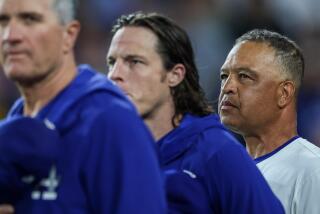It’s the end of an era in Vero
The Rise and Fall of Dodgertown
60 Years of Baseball
in Vero Beach
Rody Johnson
University Press of Florida: 256 pp., $24.95
*
Every February, without fail, my father calls with the same message: “Pitchers and catchers report.” Four little words that, to baseball fans, means the winter-long hiatus without hardball is nigh over and that, finally, all again is right with the world.
No other professional sport evokes this sort of giddy spirit. Spring training promises renewal and hope. Every rookie is a surefire Hall of Famer, and every journeyman is poised for a career year. Even the uniforms seem to shimmer.
For Dodgers fans, spring training has meant Vero Beach. The club has been based in the sleepy Florida beach town since 1948, when they were the Boys of Summer from Brooklyn. The symbiotic relationship between the team and the town is the basis of Rody Johnson’s “The Rise and Fall of Dodgertown: 60 Years of Baseball in Vero Beach.”
This is no “Ball Four”-like expose of late-night debauchery. Nor is this an “inside baseball” account of sacrifice-bunt drills and pitch-count strategy. Rather, this chronological history straightforwardly traces the post-World War II transformation of Vero, the Dodgers and the sport.
As Johnson notes, Dodgers co-owner Branch Rickey originally came to Vero, a sprawling, recently shuttered Naval Air Station with wooden barracks, to accommodate the 700 players he had under contract. But Rickey had another motive: The Mahatma had recently shocked America by signing former UCLA star Jackie Robinson and thus integrating the national pastime. He needed an out-of-the-way place where white and black ballplayers could practice together. Thus, “Dodgertown” was born.
With the smell of orange blossoms wafting over the practice fields, Rickey’s vision of an “instructional school” whipped the Dodgers into perennial winners. Da Bums dominated the National League from the late 1940s to the mid-1950s, winning six pennants and one World Series.
But change was coming, Johnson writes, after lawyer Walter O’Malley bought out Rickey’s ownership share. O’Malley began to gripe about dwindling attendance at Brooklyn’s moldy Ebbets Field. In 1957, when his demands for a new stadium went unheeded, O’Malley uprooted the team to Los Angeles and (with the San Francisco Giants) opened up a new market for Major League Baseball. It was a huge gamble, not least because O’Malley hadn’t secured final approval for his new stadium in Chavez Ravine. (Johnson notes that one of the first negotiation meetings between O’Malley and L.A. officials took place in Vero Beach in spring 1957.)
Meanwhile, as the civil-rights movement grew more forceful, black players complained about Vero’s stifling racism (and that they had to venture to Gifford, the nearby “colored town,” for entertainment and haircuts). Slowly, the Dodgers and Vero accommodated the changing mores of the 1960s. The grandstand and the restrooms at Holman Stadium were integrated; the team built a golf course and movie theater.
Johnson writes that O’Malley’s personal touch and Vero’s small-town atmosphere made for an excellent match. The Dodgers preached continuity: Only two managers, Walter Alston and Tommy Lasorda, served from 1954 to 1995, and the vaunted infield of Steve Garvey, Davey Lopes, Bill Russell and Ron Cey played together for 8 1/2 campaigns. That helped lead to World Series triumphs in 1959, 1963, 1965, 1981 and 1988. The Dodgers gave back to Vero by placing a minor league team there, one that nurtured current players James Loney and Russell Martin.
The cozy relationship would last until the 1990s. By then, Johnson writes, Vero “could no longer be called a small town” -- not with the construction of a Wal-Mart Super Center and a Disney resort. The Dodgers went from family-owned to corporate-owned, with the O’Malleys selling the club (and its Florida property) to Rupert Murdoch’s News Corp. in 1997.
Rumors immediately surfaced that the team would pull out of Florida. That proved unfounded, at least then, but the Dodgers, who haven’t been back to the World Series since ‘88, floundered. In 2004, Murdoch sold the franchise to real-estate mogul Frank McCourt. Johnson writes that spring training has changed dramatically since the halcyon days when starting pitchers actually completed games. Back then, ballplayers’ salaries were often so low that most took second jobs (often selling insurance or cars) during the off-season. Now, the players spend winters working out with personal trainers inside the private gyms of their McMansions. Now, the Grapefruit League (Florida) and the Cactus League (Arizona) are about marketing the team’s “brand” and landing the most lucrative stadium deal.
There’s no better example of this than the Dodgers, who are poised to “pull a Brooklyn” and, after 60 years, vacate Vero. Next spring, the club plans to train in Glendale, Ariz., primarily to be nearer to its fan base on the West Coast. The new facility, which L.A. will share with the Chicago White Sox, will cost an estimated $80 million. (The team has already moved its Vero Beach minor-league team to San Bernardino.)
Vero Beach didn’t mourn this loss for long. The town is reported to be negotiating with the Baltimore Orioles to replace the Dodgers.
Johnson doesn’t wax nostalgic about these developments. Dodgertown may soon be a distant memory, but he knows that Vero Beach will survive. As will baseball. Quoting former commissioner Fay Vincent, Johnson concludes: “The business of baseball is ugly; the game of baseball is lovely.”
--
David Davis is a contributing writer at Los Angeles magazine.
More to Read
Go beyond the scoreboard
Get the latest on L.A.'s teams in the daily Sports Report newsletter.
You may occasionally receive promotional content from the Los Angeles Times.










